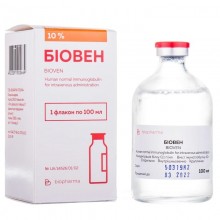



 Secure and encrypted payment processing
Secure and encrypted payment processing We ship to over 40 countries including the USA, UK, Europe, Australia and Japan
We ship to over 40 countries including the USA, UK, Europe, Australia and Japan Guaranteed refund or reship if you haven't received your order
Guaranteed refund or reship if you haven't received your orderBioven drug is an immunologically active protein fraction (distribution of subclasses of immunoglobulin g in the preparation: igg1 - 52%, igg2 - 32%, igg3 - 7%, igg4 - 4%), the limit content of immunoglobulin a in the preparation is 400 μg / ml.
Bioven Mono is an immunologically active protein fraction (IgG) isolated from human blood plasma, purified and concentrated by ethanol fractionation.
The active component of Bioven / Bioveno mono are antibodies that have specific activity against various pathogens - viruses and bacteria, including hepatitis A and B, cytomegalovirus, herpes simplex virus type I, II and VI, Epstein-Barr virus, chickenpox, influenza, measles, mumps, polio, rubella, pertussis, staphylococcus, E. coli, pneumococcus, tetanus and diphtheria toxin. They also have nonspecific activity, which is manifested by an increase in body resistance.
Bioven has low spontaneous anticomplementary activity.
Bioveno mono lacks anti-complementary properties, since the isolated immunoglobulins are purified from aggregated proteins and impurities.
Bioven is a native immunoglobulin G that retains all biological properties: complement activation, effector and opsonophagocytic functions.
Bioven / Bioveno mono is an immunologically active protein fraction isolated from human serum or plasma, tested for the absence of antibodies to HIV-1, HIV-2, hepatitis C virus and hepatitis B virus surface antigen, purified and concentrated by alcohol fractionation water precipitants, which went through the stage of viral inactivation by the solvent-detergent method.
Data on the effectiveness of inactivation of model viruses are shown in the table below.
The effectiveness of inactivation / elimination of viruses
| Virus | Title Drop Factor | The result of the study by PCR * |
| Human Immunodeficiency Virus I | 5.0 lg TCID50/cm3 | — |
| Hepatitis C virus | 5.5 lg TCID50/cm3 | — |
| Herpes simplex virus type II | 6.0 lg TCID50/cm3 | — |
| Cattle viral diarrhea virus | 5.5 lg10 TCID50/cm3 | — |
| Pseudorabies virus | 6.3 lg10 TCID50/cm3 | + |
| Type I swine enterovirus | 4.6 lg10 TCID50/cm3 | + |
| Type IV Human Adenovirus | 1,2 lg10 TCID50/cm3 | + |
| Type I ducklings hepatitis virus | 3.3 lg10 ELD50/cm3 | n / a |
| Vesicular Stomatitis Virus | 7,0 lg10 TCID50/cm3 | n / a |
* PCR - polymerase chain reaction; n / a - no data.
High drug efficacy is ensured by the rapid and 100% entry of antibodies into the bloodstream and normal T½ out of the body.
After administration, the bioavailability of normal human immunoglobulin in the bloodstream of the recipient is immediate and complete. It is quickly distributed between blood plasma and extravascular fluid, after about 3-5 days a balance is reached between the intra- and extravascular spaces.
T½ normal human immunoglobulin is about 40 days. This t½ may vary in each individual patient, especially with primary immunodeficiency. IgG and IgG complexes break down in the cells of the reticuloendothelial system.